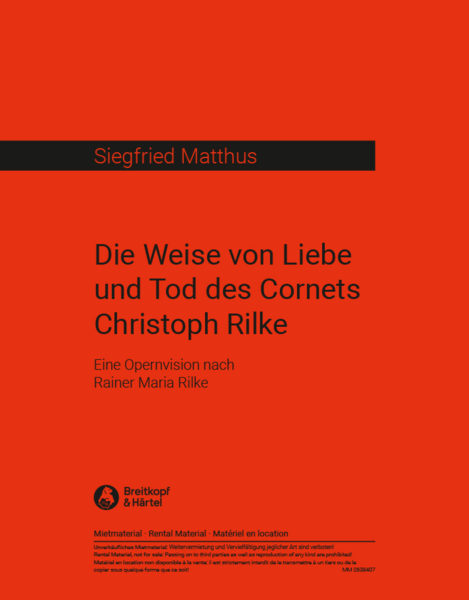Siegfried Matthus (1934–2021) Die Weise von Liebe und Tod des Cornets Christoph Rilke
Eine Opernvision nach Rainer Maria Rilke 1983/84 Dauer: 100' Text: Siegfried Matthus
Soli: SSSMezABarB – Chor: SATB – 4.0.0.0. – 1.0.0.0. – Pk.Schl(2) – 2Hfe.E-Bass – Sturmglocke
Uraufführung: Dresden (Wiedereröffnung der Semperoper), 1985
Nachdem Sie die gewünschten Ausgaben in den Warenkorb gelegt haben, können Sie dort die benötigte Stückzahl bei Bedarf noch anpassen.
Libretto: Siegfried Matthus nach Rainer Maria Rilke
Englische Übersetzung: B. Jacobson
Ort und Zeit: Ungarn, während des Türkenkriegs 1683 oder jederzeit, im Schloß der Gräfin, im Traum und in der Realität
Personen: Cornet Christoph Rilke auf Langenau (Mezzosopran) - Seine Gedankenstimme (Alt) - Gräfin (Sopran) - Ihre Gedankenstimme (Sopran) - Marquis (Bariton) - Graf Spork (Bass) - Ein junges Weib (Sopran) - Soldaten, Dirnen, Gäste auf dem Schloßfest (Chor)
Der junge Christoph Rilke von Langenau zieht mit seinem Heer gegen die Türken in den Krieg. Dort befreundet er sich mit dem Marquis und erhält von ihm beim Abschied ein Rosenblatt, das er immer bei sich trägt. Sie reiten durch endlos weites Land und treffen schließlich auf das feindliche Heer. Rilke wird von Graf Spork zum Fahnenträger - Cornet - ernannt. Kriegserlebnisse belasten seine Psyche schwer, Visionen bringen ihn an den Rand des Wahnsinns. Bei der Übernachtung in einem Schloß erlebt Rilke seit langer Zeit Ruhe und Erholung sowie seine erste Liebesnacht mit der Gräfin. Ein feindliche Angriff stört die Idylle: das Schloß geht in Flammen auf, Rilke stürzt sich in die Schlacht und kommt darin um. Matthus stellt der Oper den Chor "In solchen Nächten / war einmal Feuer in der Oper” voran, dem ein Rilke-Text aus dem "Buch der Bilder” zugrundeliegt. Ursprünglich war dieser Chorsatz nur für die Uraufführung zur Wiedereröffnung der Semperoper 1985 - also 40 Jahre nach ihrer Zerstörung - gedacht, ist aber letztlich zu einem untrennbaren Bestandteil des Werkes geworden.
CD:
Christina Ascher (Mezzosopran), Claudia Eder (Alt), Marcella Polidori
(Sopran), Birgit Fandrey (Sopran), Hermann-Christian Polster (Bass), Chor des Norddt. Rundfunks / Ein Instrumentalensemble, Ltg. Hartmut Haenchen
CD Musik in Deutschland 1950-2000
Deutscher Musikrat 74321 73543
CD (Ausschnitte):
Christina Ascher (Mezzosopran), Claudia Eder (Alt), Marcella Polidori (Sopran), Birgit Fandrey (Sopran), Hermann-Christian Polster (Bass), Chor des Norddeutschen Rundfunks / Ein Instrumentalensemble, Ltg. Hartmut Haenchen
CD BMG 74321 73543 2
Bibliografie:
Dieckmann, Friedrich: Die gefesselte Jugend. Rilkes „Cornet“ als Oper einer Vision, in: Weimarer Beiträge 6/1986.
Gennrich, Judith: „Ich bin ein Sänger ohne Stimme“. Siegfried Matthus’ Kompositionsweise für die Singstimme am Beispiel der Opern „Die Weise von Liebe und Tod des Cornets Christoph Rilke“ und „Judith“. Musiklehrer-Diplomarbeit Mainz 1997.
Matthus, Siegfried: Meine „Cornet“-Oper, in: Programmheft der Uraufführung an der Dresdner Staatsoper 1985.
ders.: „Cornet“ oder Über die Kunst, zu erben. Ein Werkstattgespräch, in: Musik und Gesellschaft 1/1985.
ders.: Über die Harmonik meiner „Cornet“-Oper, in: Musik und Gesellschaft 8/1987.
ders.: „Die Weise von Liebe und Tod des Cornets Christoph Rilke“. Interpretationserfahrungen, in: Wanderer zwischen Musik, Politik und Recht. Festschrift für Reinhold Kreile zum 65. Geburtstag, hrsg. von Jürgen Becker, Baden-Baden 1994, S. 403ff.









